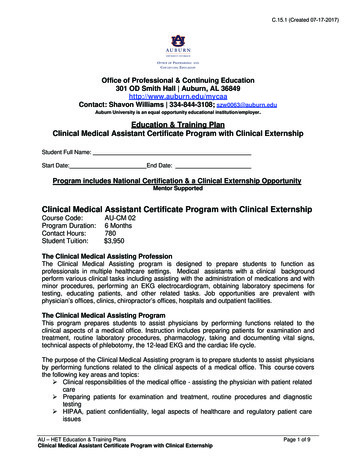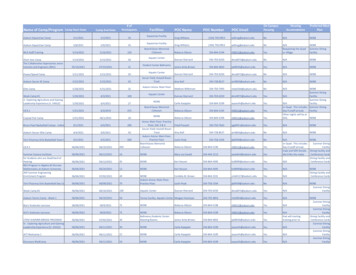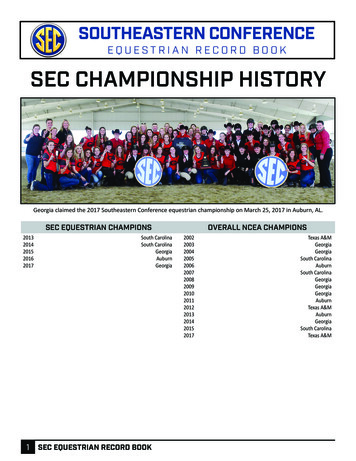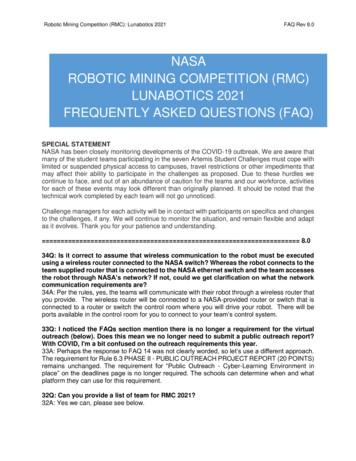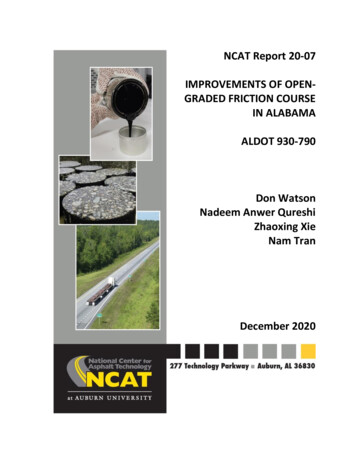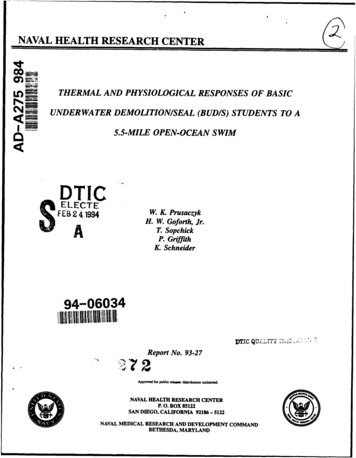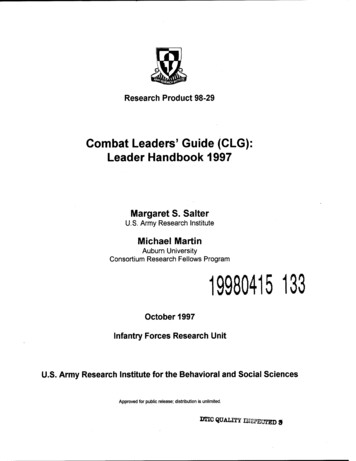
Transcription
Research Product 98-29Combat Leaders' Guide (CLG):Leader Handbook 1997Margaret S. SalterU.S. Army Research InstituteMichael MartinAuburn UniversityConsortium Research Fellows Program19980415133October 1997Infantry Forces Research UnitU.S. Army Research Institute for the Behavioral and Social SciencesApproved for public release; distribution is unlimited.«no QUALITY DEFECTED 3
U.S. Army Research Institutefor the Behavioral and Social SciencesA Directorate of the U.S. Army Total Personnel CommandEDGAR M. JOHNSONDirectorTechnical Review byMAJ James P. Reeves, ARISGT Michael Lee Sparks, USARNGNOTICESFINAL DISPOSITION: This Research Product may be destroyed when it is no longerneeded. Please do not return it to the U.S. Army Research Institute for the Behavioraland Social Sciences.NOTE: This Research Product is not to be construed as an official Department of theArmy position, unless so designated by other authorized documents.
REPORT DOCUMENTATION PAGE1. REPORT DATE2. REPORT TYPE3. DATES COVERED (from. to)1997, OctoberFinalApril 1997-Oetober 19975a CONTRACT OR GRANT NUMBER4. TITLE AND SUBTITLECombat Leaders' Guide (CLG): Leader Handbook 19975b. PROGRAM ELEMENT NUMBER0602785A6. AUTHOR(S)5c. PROJECT NUMBERMargaret S. Salter (ARI) and Michael Martin (Auburn University)5d. TASK NUMBERA790212C5G.WORK UNIT NUMBERH017. PERFORMING ORGANIZATION NAME(S) AND ADDRESS(ES)8. PERFORMING ORGANIZATION REPORT NUMBERU.S. Army Research Institute for the Behavioral and Social SciencesInfantry Forces Research UnitP.O. Box 52086Fort Benning, GA 31995-20869. SPONSORING/MONITORING AGENCY NAME(S) AND ADDRESS(ES)U.S. Army Research Institute for the Behavioral and Social SciencesATTN: TAPC-ARI-IJ5001 Eisenhower AvenueAlexandria, VA 22333-560010. MONITOR ACRONYMARI11. MONITOR REPORT NUMBERResearch Product 98-2912. DISTRIBUTION/AVAILABILITY STATEMENTApproved for public release; distribution is unlimited.13. SUPPLEMENTARY NOTES14. ABSTRACT (Maximum 200 words):The Combat Leaders' Guide (CLG) is a job performance aid for leaders to use as a memory jogger during realistic combattraining like that at the Combat Training Centers or in continuous operations environments. The CLG is a pocket-sized, quickreference system to be used by trained soldiers at company, platoon, or squad level. The CLG helps to overcome the effects ofperformance decay over time and during periods of high stress and fatigue. It supports unit readiness by providing a leaderwith doctrinal, tactical, and technical materials in a quick-reference format.15. SUBJECT TERMSLeader GuideCombat Leaders' Guide (CLG)SECURITY CtASSIFICATJOK OF16. REPORT17. ABSTRACT18. THIS PAGEUnclassifiedUnclassifiedUnclassified19. LIMITATION OFABSTRACTUnlimitedJob Aids20. NUMBEROF PAGES24021. RESPONSIBLE PERSON(Name and Telephone Number)
Research Product 98-29Combat Leaders' Guide (CLG):Leader Handbook 1997Margaret S. SalterU.S. Army Research InstituteMichael MartinAuburn UniversityConsortium Research Fellows ProgramInfantry Forces Research UnitScott E. Graham, ChiefU.S. Army Research Institute for the Behavioral and Social Sciences5001 Eisenhower Avenue, Alexandria, Virginia 22333-5600October 1997Army Project Number2O26785A790Personnel Systems andPerformance TrainingApproved for public release; distribution is unlimited.Preceding Pag f Blankiii
FOREWORDThe U.S. Army Research Institute for the Behavioral andSocial Sciences Infantry Forces Research Unit conducts researchand development on training methods and technologies to maximizecombat effectiveness. Much of this research has resulted inuseable products for soldiers. The "Combat Leaders' Guide:Leader Handbook 1997 is the latest version of a prototype pocketsized job performance aid to be used by trained soldiers. Earliereditions of the CLG have been distributed to over 30,000 soldiersthroughout the world, and it is in use in both Active and ReserveComponent tactical units.The newest edition of the CLG was developed with theassistance and support of the Fort Benning Special Assistant tothe Commanding General, Army National Guard (ARNG). The ARNGOffice will continue to distribute copies of the CLG to units andindividuals who request it. Recipients include personnel in theNational Guard's Officer Candidate Schools, Reserve OfficerTraining Courses, arid both National Guard and FORSCOM units, aswell as trainers at TRADOC Schools and professional developmentacademies. CLGs are also in use at the Combat Training Centers.The CLG supports unit readiness by providing leaders withdoctrinally correct tactical and technical information in aquick, easy to access format. 'The CLG can provide increasedoperational capability through standardization and enhancedleader readiness.ZITA M. SIMUTISTechnical Directorv
ACKNOWLEDGMENTSThe Combat Leaders' Guide owes its primary success to thesoldiers who use and request it. It also owes its success tothose who make distribution possible. First, and foremost, COLHoward L. Willis, Jr., has again provided enthusiastic supportfor the CLG project. His efforts included providing threesoldiers who acted as consultants: LT Jamie Kirby, SGT EmmettRose, and SGT Michael Sparks. We are grateful to all of them.VI
COMBAT LEADERS' GUIDE (CLG):LEADER HANDBOOK 1997CONTENTSPageINTRODUCTION . . . . . .BACKGROUND. . . . . . '. . . . .'.' . . ., . . . ".' . . . .NATIONAL GUARD ASSISTANCE. . . .1'. . . . . . . . ,. . .I. /'." . . . .'. . . :. . . . . 3CLG STATUS . . . '. '.; ;. . v . . . . . . . . . .REFERENCES . . . . , . , . . . .APPENDIX A. .3. .5COMBAT LEADERS' GUIDE (CLG): LEADER HANDBOOK 1997 A-1Vll
Combat Leaders' Guide (CLG):Leader Handbook 1997IntroductionThe Combat Leaders' Guide (CLG) was originally developed bythe Army Research Institute's (ARI) Infantry Forces Research Unitfor the TRADOC Training Technology Agency. The intent was todevelop a standardized job performance aid for already trainedsoldiers to use as a memory jogger. This job aid would helpleaders to overcome effects of procedural decay over time as wellas to provide assistance during the stress and fatigue ofcontinuous combat operations, and during realistic combattraining.The CLG is a pocket-sized handbook containing tasks fromSoldiers' Manuals and other training materials, in easy to readchecklist format, on water and tear resistant paper. It fastenswith rings for easy insertion or removal of material althoughsoldiers can customize it with screws or cord as desired. TheCLG provides fast information recovery, can be personalized toindividual and unit needs, and is usable under low light and ininclement weather. It also includes a clear pocket and a gridsquare with both 1/25,000 and 1/50,000 grids. The CLG is ageneric guide that requires little updating.BackgroundPreliminary CLGs: 1985-1990The original brown covered CLG, Combat Leaders' Guide: RiflePlatoon and Squad (Winn, Evensen & Salter, 1987b) was based on anextensive front end analysis of basic military tasks andmissions. Winn and Evensen's 1987 Authoring Guide documented theclear decision rules used for task and format selection. ARIprinted the CLG as a test item in 1986 and handed out nearly 1000copies with questionnaires for comments. Recipients includedofficers and soldiers of all ranks from both the active andreserve component. Additional review copies went to retiredofficers and training developers from various TRADOC schools.Analyses and summaries from the returned questionnaires werereported in Evensen, Winn, and Salter (1988).Incorporating comments received on the first CLG, a secondedition, the gray covered Combat Leaders Guide - Platoon Leaders,Platoon Sergeants and Squad Leaders (Winn, Evensen, & Salter,
1987a) was printed in 1987 and reprinted in 1990. The bookreceived immediate positive response, and several thousands ofcopies were distributed. User feedback indicated that the CLG'sappeal was that it included basic information in a useful anduseable format.The non-specific nature of the book, its unusual format andrelatively high cost became a limitation. From 1987 to 1990, ARImade numerous unsuccessful attempts to turn the CLG over toTRADOC or to another agency. Simultaneously, the CLG wasbeginning to enjoy such wide dissemination that requests werecoming from active and reserve component units, including manydeployed in Korea and Germany. Schools of military science andROTC units also requested copies. ARI's intent had been todevelop a prototype; the prototype was so successful that it hadbecome an end itself.Impact of Operation Desert Storm on the CLGDespite its obvious success, ARI canceled the CLG projectafter the second printing due to lack of sponsorship. However,beginning in mid-August 1990, the Fort Benning Research Unitbegan to receive urgent requests for multiple copies of the CLGfrom units deploying to Operation Desert Shield/Desert Storm.Requests came from the 24th Infantry Division at Forts Stewartand Benning, and the 1st Infantry Division at Fort Riley.Similar inquiries came from the 48th and 155th Infantry Brigades(Georgia and Mississippi Army National Guard), in anticipation ofdeployment. Shortly thereafter, the 12th Cavalry Regiment (FortKnox) asked for CLGs to support training of Individual ReadyReserve soldiers being called up for deployment. The finalsupplies of the CLG were exhausted by requests from, for example,combat service support units already in Saudi Arabia.In response to the demonstrated need, and after surveyingsoldiers called up for Operation Desert Storm, ARI printed arevised and updated version, Combat Leaders' Guide: LeaderHandbook (Salter, 1993). This book was smaller, with fewerpages, and circular rings to hold the pages together, replacingthe screws of the original two versions. Incorporating usercomments, some content was changed to make the book more useful.Items felt unnecessary or inappropriate for the target audienceof company grade and below leader were deleted; some extramaterial was added. The new and revised content, suggested bypersonnel from the Georgia, Mississippi and Louisiana NationalGuard, was evaluated by senior personnel from Fort Benning. TheDesert Storm CLG was printed with tan covers to distinguish itfrom the previous versions.
National Guard AssistanceIn late 1993 the CLG: Leader Handbook was reprinted by theSpecial Assistant to the Commanding General, Army National Guard(ARNG), Fort Benning, for nationwide distribution to ARNGinfantry battalions. It was first printed on regular paper, thenon the special paper of the standard CLG. It was an instantsuccess. Requests came from Guard units, and from active dutyunits as well.As the ARNG supplies dwindled, the CLG was again updated andrevised. Subject matter experts from throughout Fort Benningreviewed the latest CLG. The new product, Combat Leaders' Guide:Leader Handbook 1994 (Salter, 1994) was printed by the ARNG.There were few content changes from the previous version,although some materials were added. New sections on RiskAssessment, Rules of Engagement, and Peacekeeping, made the bookmore relevant to stability operations missions. The 1994 CLG wasprinted with a forest green cover.1997 Combat Leaders' GuideSince supplies of the 1994 version (both the original and areprint) are nearly gone, ARI and the ARNG have constructedanother CLG. Senior cadre from the ARNG Pre-Ranger Course, inconjunction with ARI and Infantry School personnel, reviewed the1994 CLG and updated it as necessary. There were few contentchanges, although some diagrams and charts were clarified. Somepages were reordered to make the CLG even more user friendly.The newest CLG, Combat Leaders' Guide (CLG) - 1997 Leader'sGuide, is at Appendix A to this report. The title and date showthe continuity with the four previous books; again the ARNGOffice at Fort Benning is printing and distributing the product.This version of the CLG will first be printed on regular paperwith a camouflage type cover; it will be printed using thespecial paper at a later date as funds become available. Plansare also underway to place the CLG on the Internet.CLG StatusMore than 40,000 CLGs are in worldwide distribution. Usershave been overwhelmingly supportive of the CLG as evidenced bythe continuing individual and unit requests. CLGs are used inclassroom instruction, during field exercises and unitevaluations, and at the Combat Training Centers. The CLG
provides a leader with doctrinal, tactical and technicalmaterials in a quick reference format. The CLG offers potentialfor increased operational capability by ensuring maintenance ofleader readiness.There are lingering potential problems. There will alwaysbe some disagreement as to the appropriate content and theemphasis given to each section within the Guide. Interest in orallegiance to any section often corresponds to the individualreviewer's present job description. This issue has been resolvedby focusing on a wide range of Infantry skills. Information withonly a limited audience has been deleted. Personnel withspecialized skills can use the book for its overall Infantryinformation, and use other sources for specific subject matter.There is still some concern over the intended primaryaudience for the CLG. While there have been users across ranksand functional areas, the appropriate target audience is probablythe company level and lower leader, especially the platoonleader, the platoon sergeant and squad leader. Personnel atbattalion level and higher tend to have other sources for jobrelated information and staffs have ready access to job-specificmanuals and publications.The CLG is a prototype item, and although based on doctrinalmaterials, it is not part of the doctrinal literature program.Local reproduction has always been both authorized and encouragedas the CLG is expensive to produce, and limited in availability.Although there is no formal requirement for a job aid for thesmall unit leader, and although other job aids are available,requests continue unabated for copies of the CLG. The CombatLeaders' Guide fills a soldier need.
ReferencesEvensen, E. B., Winn, R. B., & Salter, M. S. (1988). Evaluationof a job aid system for combat leaders: Rifle platoon andsquad (ARI Research Report 1465).Alexandria, VA: U.S.Army Research Institute for the Behavioral and SocialSciences.Salter, M. S. (1993). Combat leaders' guide: Leaderhandbook (ARI Research Product 93-01). Alexandria, VA:Army Research Institute for the Behavioral and SocialSciences. (AD A263 416)U.S.Salter, M. S. (1993). Combat leaders' guide updated: Theleader handbook (ARI Research Note 93-13). Alexandria, VA:U.S. Army Research Institute for the Behavioral and SocialSciences. (AD A263 479)Salter, M. S. (1994). Combat leaders' guide: 1994 leaderhandbook (ARI Research Product 95-03). Alexandria, VA: U.S.Army Research Institute for the Behavioral and SocialSciences. (AD A286 010)Winn, R. B. & Evensen, E. B. (1988). Authoring guide: A job aidto design and produce a combat leaders' guide (ARI ResearchProduct 88-14). Alexandria, VA: U.S. Army Research Institutefor the Behavioral and Social Sciences.Winn, R. B., Evensen, E. B., & Salter, M. S. (1987a). Combatleaders' guide: Platoon leaders, platoon sergeants, andsquad leaders (ARI Research Product 87-33). Alexandria, VA:U.S. Army Research Institute for the Behavioral and SocialSciences.Winn, R. B., Evensen, E. B., & Salter, M. S. (1987b). Combatleaders' guide: Rifle platoon and squad (ARI ResearchProduct 87-23). Alexandria, VA: U.S. Army ResearchInstitute for the Behavioral and Social Sciences.
COMBAT LEADERS'GUIDE(CLG)LEADER HANDBOOKARMY RESEARCH INSTITUTEINFANTRY FORCES RESEARCH UNIT1997A-l
N COCOwLUCMrzomz* sOlHm"Hrn33COO)Nl»to
INTRODUCTIONThe Combat Leaders' Guide is both anextract of doctrinal publications and acompilation of tactics, techniques andprocedures(TTPs). It is principallydesigned as a pocket reference andmemory-jogger.Some TTPs you have learned in trainingdo not appear here. The material in thisjob aid comes from the doctrinalliterature program.Laminate pages to be written on;remove, reorganize or tab pages basedon your mission; insert other job aids,TTPs or SOPs as needed.Questions? Call SACG at Ft. Benning,DSN 835-5741 LT Kirby, SGT Rose, SGTSparks.
TABLE OF CONTENTSBASIC COMBAT RULES PAGELeading in combatBasic rules of combat1-11-2PLANTroop leading proceduresWarning orderFactors of METT-TEstimate of the situationOperation order (OPORD)Fragmentary order (FRAGO)Time scheduleLight and weather data2-12-22-32-82-152-192-202-21MOVEActions before marchDuties of quartering partyMarch ordersActions during marchActions at haltsActions at assembly area3-13-23-33-43-53-6
TABLE OF CONTENTSATTACKPAGEPreparation for fensive priority of workDefense planning outlineCoordination checklistEstablish observation postFighting position guidelinesBuilding fighting positionRange card preparationRange card (blank)Range card (sample)Sector sketch preparationSector sketch (sample)Occupation of a battle position5-15-35-55-75-85-95-115-135-145-155-175-18
TABLE OF CONTENTSDEFENDPAGEFighting from a battle positionFire distribution and controlCamouflagePhysical securityDefending during limited visibility5-195-205-215-225-24DELAYFundamentals of delay6-1WITHDRAWDisengagement planningDisengagement actionsPassage of lines coordinationWithdrawal under enemy pressureWithdrawal not under enemypressureRelief in place7-17-27-37-47-77-11
TABLE OF CONTENTSPAGEPATROL/RECONPatrol planning stepsPatrol coordinationComplete the planDeparture from friendly linesRally pointsPatrol report (debriefed)Selection of a patrol baseOccupation of a patrol basePatrol base activitiesPrinciples of a raidConduct a raidPrinciples of an ambushOrganize an ambushConduct an ambushPlan a recon missionRecon zoneRecon -198-218-238-25
TABLE OF CONTENTSPAGENBCNBC-1 reportNBC-4 reportNBC-prior to attackNBC-during attackNBC-after attackUnmasking with chemical agentdetector kitUnmask without chemical agentdetector kitMOPP levelsDetailed troop deconMOPP gear exchangeMark contaminated area:radiological/bio/chemPrepare for NBC attack/protectagainst electromagnetic pluseSupervise radiation monitoringUsing a dosimeterCollect/report total radiation -179-18
TABLE OF CONTENTSFIRESUPPORTANDOBSERVATION PAGEPrinciples of fire supportplanning/coordinationCall for fireCall for fire cardTarget list worksheetMortar/artillery capabilitiesAFV Weapon capabilitiesTarget acquisition/signatureAttack helicopter capabilitiesArtillery PPLIES/LOGISTICSSupplies and logistical servicesPrecombat check (mech)Precombat check (light)Classes of supply11-111-211-311-4COMMOElectro counter-countermeasuresRadio troubleshootingSplicing field wireInstalling commo lines12-112-212-312-5
TABLE OF CONTENTSPAGECOMMOCrossing objects with commo linesMessenger briefing12-612-7MINES/DEMOInstall/remove hasty protectiveminefieldDA Form 1355-1-R sampleDA Form 1355-1-R (blank)Breaching and clearing minefieldsNonelectric firing systemNonelectric/electric priming ofdemo blockClear nonelectric/electric misfiresElectric firing NGRules of engagement (ROE)Area assessment checklistCheckpoint/roadblock PIRchecklist14-114-214-4
TABLE OF CONTENTSAIR ASSAULT OPERATIONS PAGEAircraft troop commander briefingSafety briefing checklistReverse planning sequenceGround tactical planconsiderationsLanding plan considerationsLanding zone selection criteriaAir assault PZ/LZ planningconsiderationsExtraction loading planrequirementsLeader duties in air assaultoperationsChalk leader duties/platoon airassaultSet up a helicopter landing siteNight marking of 5-1115-13
TABLE OF CONTENTSPAGEMEDICALEvaluate a casualty/first aidShock - symptoms/first aidHeat exhaustion/heat crampsHeat stroke/sun strokeFrostbiteHypothermia/cold weather injuryRequest army air MEDEVACContinuous operations planningHeat HICLE RECOVERYVehicle recovery procedure checklistVehicle recovery fundamentals17-117-2AIR DEFENSEEngaging aircraftWeapons control statusAir defense warningLocal air defense warningEngagement/lead distancesPassive air defense18-118-118-218-218-318-4
TABLE OF CONTENTSCOMBAT IN CITIES PAGEBuilt-up area fighting principlesAttack and clear a buildingOrganize building defense19-119-219-3LEGAL ASPECTS OF WARPrinciples of the Law of WarRules of engagement (ROE) andthe law of warHandling of enemy prisoners ofwar (EPWs)MISCELLANEOUSSpot report/SALUTEFind unknown range (WORM)Conversion table: US/metricConverting azimuthsReduce risk of fratricide1020-120-320-4
TABLE OF CONTENTSMISCELLANEOUS PAGERisk managementRisk management stepsRisk management matrixPersonnel records21-721-821-1021-11ACRONYMSAcronyms22-111
LEADING IN COMBAT1Set the example2Lead from as far forward as you can3Lead from a position where yoursoldiers can see you/your vehicle4Lead from where you can control allelements physically or by radio5Move to influence the action6Make sound, quick decisions7Forcefully execute decisions8Use reverse planning sequenceNotes:11-11
BASIC RULES OF COMBATTYPE1RULESECUREUse cover and concealmentEstablish local security/reconMOVEEstablish moving element/moveto position of advantageGain and maintain initiativeSHOOTEstablish base of fire/mutualsupportKill/suppress enemyCOMMUNICATEInform everyone/tell soldiers whatyou expectSUSTAINKeep fight going/care for soldiers1i1-21
TROOP LEADING PROCEDURESSTEPACTIONReceive missionIssue warning orderMake tentative planInitiate necessary movementConduct ReconnaissanceComplete planIssue orders8Supervise and refineNotes:2-1Z
WARNING ORDER1. Situation2. Mission3. General Instructionsa. Special teams/task organizationb. Common uniform/equipmentc. Special weapons, ammo, equipmentd. Tentative time schedule4. Special Instructions2-2
FACTORS OF METT-T(FACTORS APPLY TO FR & EN)ITEM1FACTORSMISSIONIntent one & two levels upSpecified tasksImplied tasksMission essential tasksLimitations/constraintsRestated mission2-3
FACTORS OF ngthRecent activitiesWeaknessesPossible COAsProbable COAsReinforcement abilities2-4 /
FACTORS OF METT-TITEM3FACTORSTROOPS AVAILABLEKey leadersDispositionCompositionStrength tenance levelCombat service support2-5s/
FACTORS OF METT-TITEMFACTORS4TERRAIN (OCOKA)Observation/Fields of fireCover & concealmentObstaclesKey terrainAvenues of approach2-6v/
FACTORS OF METT-TITEMFACTORSTIMEPlanning & preparationof combat ordersInspections &rehearsalsMovementLine of departureStart, critical, releasepointsUse 1/3 - 2/3 rule2-7v/
ESTIMATE OF THE SITUATION1. Detailed Mission analysisa. Mission/intent of commander 2levels upb. Mission/intent of immediatecommanderc. Tasks & purpose/specified& impliedd. Mission essential taskse. Constraints & limitationsf.Restated missiong. Tentative time schedule2-8
ESTIMATE OF THE SITUATION2. Estimate situation/develop courseof actiona. Terrain & weather - effects onpersonnel & rvivabilityb. Enemy situation & engthsWeaknessesWeapons/unitsMost probable COA basedon doctrine/situation2-9
ESTIMATE OF THE SITUATIONc. Friendly situationTroops availableEquipment availableTime availabled. Friendly COA (repeat foreach COA)Decisive point & time tofocus combat powerResults that must beachievedPurposes & tasks of main& supporting effortsTask organization toaccomplish missionControl measurese.Prepare a COA statement& sketch2-10
ESTIMATE OF THE SITUATION3. Analyze COAsMission specific factorsmission essential taskscommander's intentrelative effectivenesslogistic supportGeneral Factorscharacteristics of offense anddefenseMETT-Tweapon utilization2-11
ESTIMATE OF THE SITUATION4. Compare Courses of Actionconsidering how well theCOA:Supports schemeof maneuverHelps command& controlConcentrates combatpower at decisive pointForces providemutual supportResponds to maneuverelements & reserve2-121 2 3
ESTIMATE OF THE SITUATION4. Compare Courses of Actionconsidering how well theCOA:Exploits enemy weaknessAccounts for weatherUses best avenue ofapproachProvides enoughmaneuver spaceMaximizes observation &ranges of weaponsystemsProvides cover &concealment2-131 2 3
ESTIMATE OF THE SITUATION4. Compare Courses of Actionconsidering how well theCOA:Considers obstaclesControls key terrainHelps speed of executionDoes not requireadjustment of unitpositionsUses all HQsRequires normal CSS5. Decision2-141 2 3
OPERATION ORDERTask organization:.1. Situationa. Enemy forces:.b. Friendly forces:Mission/concept higher.Location & actions of units onleft, right, front, rearUnits providing fire support.2-15
OPERATION ORDER2. Mission.3. ExecutionIntenta. Concept of the operation(1) Maneuver.2-16
OPERATION ORDER(2) Firesb. Tasks to maneuver units.c. Tasks to combat support unitsd. Coordinating instructions.(1) Time schedule(2) PIR2-17
OPERATION ORDER4. Service Support:a. General:5. Command and Signala. Command:b. Signal:2-18
FRAGMENTARY ORDER(FRAGO provides changes to anexisting order. Address only elements that have changed)ReferenceTask organization1. Situation.2. Mission.3. Execution4. Service Support.5. Command/Signal.2-19
TIME SCHEDULEWHENWHEREWHAT2-20WHO
LIGHT AND WEATHER DATAITEMFIRST DAYBMNT/EENTSun RiseSun SetMoon Rise% IliumMoon SetNVG HoursTemp High/LoWindsPrecipEffects of light & weather:2-21NEXT DAY
ACTIONS BEFORE MARCHSTEPACTION1Give warning order2Select quartering party NCO andsend to team CP3Recon route from AA to SP4Record time from AA to SP5Adjust departing time from AAto arrive at SP on time6Have crews perform precombatchecks7Have vehicle commanders reporttheir status8Give march order to vehiclecommanders3-1V
DU"riES OF QUARTERING PARTYSTEPACTION1Inspect intended assembly areafor enemy NBC/mines2Secure platoon area untilplatoon arrives3Establish and maintain commo4Clear or mark obstacles5Select general location ofvehicle positions; mark places6Select covered/concealed routeto RP; meet platoon7Guide platoon into area8Brief platoon leader3-2si
MARCH ORDERS1. Destination (map)2. Route of march (map)3. Location of SP, critical points, RP(map)4.5.6.7.8.SPtimeMarch interval (meters)March speed (mph/kph)Catch up speed (mph/kph)Time and location of scheduled halts9. Time unit leaves present position10. Order of march3-3
ACTIONS DURING MARCHITEMACTION1Arrive at SP on time at marchspeed with proper march interval2Maintain ground and air security3Observe vehicle sectors ofresponsibility4Report SP, critical points, RP(unless under radio listeningsilence)5If under radio listening silence use hand and arm signals, flagsignals, or flashlight signals3-4V
ACTIONS AT HALTSITEMACTION1Pull to side of route - maintainorder2Establish/maintain security3Move disabled vehicles offroad - post guides to directtraffic4Maintain observation/contactwith other vehicles5Report status6Take appropriate actions/repairvehicles if possible3-5V
ACTIONS AT ASSEMBLY AREAITEMACTION1Follow guides into preselectedsecure positions2Clear RP without halting3Emplace/maintain security/OPs4Conduct fire planning5Establish wire commo net/coordinate with other units6Check/adjust positions;camouflage positionsStart maintenance/resupply/rearming78Prepare/rehearse reaction plan3-6 /.
PREPARATION FOR ATTACKACTIONTASKIssue warning order12Move to assembly area34Perform commo checkCheck weapons5Check key equipment6Rehearse critical tasks7Recon rtes to LD/OBJ8Issue OPORD9Resupply, rearm, refuel10Coordinate w/higher,supporting, adjacent units11Rehearse12Conduct PMCS as required13Check/integrate attachments4-1V
PFIEPARATION FOR ATTACKTASKACTION14Check NBC situation/confirmMOPP status15Inspect troops16Inspect vehicles17Feed troops18Rest troops19Move to LDNotes:Several steps may occur concurrently.4-2v/
CONSOLIDATIONSTEPACTION1Eliminate all remaining enemyresistance on objective2Occupy hasty positions/prepare for counterattack3Bring up base of fire element4Prepare for a counterattack5Position key weapon systems6Develop quick fire plan7Prepare range cards8Begin planning to continueattack (map recon, orders)Notes:4-3 l
REORGANIZATIONSTEP1ACTIONReestablish chain ofcommandRestore commo withhigher, adjacent, FSOReport status: ACE (AMMO/Casualties/Equipment)Request resupply as needed2Reestablish security/prep forcounterattackReman key weaponsRedistribute ammo, supplies,equipment as needed3Clear objective of casualties &EPWTreat, evacuate, process4-4V
REORGANIZATIONSTEP4ACTIONPrepare for next missionRelocate weapons & positionsReoccupy & repair positionsRepair obstacles & minesRepair & maintain equipmentNotes:4-5si
DE FENSIVE PRIORITY OF WORKSTEPTASK1Establish local security2Position key weapons & vehicles3Posn sqds/assign sectors4Set up commo net5Coordinate with adjacent unitsfor interlocking sectors6Clear fields of fire7Prepare range cards8Prepare squad & platoonsector sketches9Site final protective line(FPL) and fires (FPF),priority targets5-1V
DEFENSIVE PRIORITY OF WORKSTEPTASK10Prep fighting positions11Emplace mines & obstacles12Establish fire control measures13Assign alternate & supplementary battle positions14Take NBC protective measures15Improve primary positions16Prep alternate then suppl posns17Establish sleep/rest plan18Recon supply/evac routes19Rehearse actions on contact20Stockpile ammo, food, water21Continue to improve positions5-2N/
DEFENSE PLANNING OUTLINE1. Commander's intent2. Platoon/squad mission3. Position
The Combat Leaders' Guide (CLG) is a job performance aid for leaders to use as a memory jogger during realistic combat training like that at the Combat Training Centers or in continuous operations environments. The CLG is a pocket-sized, quick reference system to be used by trained soldiers at company, platoon, or squad level.

